#s.h.morgan
Photo

Ama-no-zako
天逆毎 (あまのざこ)
Heavenly Beast Princess
From the now defunct site Obakemono Project:
It is said that once the storm god Susano-o-No-Mikoto let his raging spirit build up inside him until, like a grotesque Athena, this princess deity burst forth. She had a beastly head with long ears, nose, and fangs, the latter of which were so strong they could easily chew through steel blades, and she could fly for thousands of miles at a go. This ferocious female spirit is considered the ancestor of such creatures as Ama-no-jaku and the tengu.
Art by S.H.Morgan
Check out these links for more on Ama-no-zako
http://yokai.wikia.com/wiki/Amanozako
http://yokai.com/amanozako/
#ama-no-zako#amanozako#obakemono project#yokai#youkai#kami#japanese folklore#japanese monster#monster girl#s.h.morgan
78 notes
·
View notes
Photo
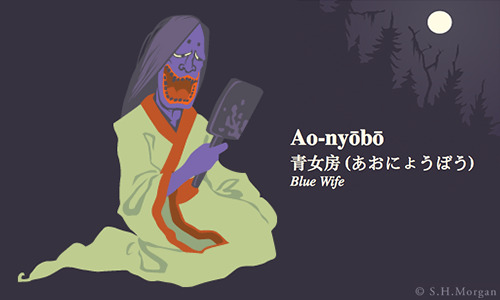
Ao-nyōbō
青女房 (あおにょうぼう)
Blue Wife
From the now defunct website Obakemono Project:
In the ruins of an old imperial palace, one might encounter this female ghoul, who seems to be the ghost of an old-fashioned court lady with blackened teeth and shaved eyebrows. She is rumored to devour young men who visit her.
Art by S.H.Morgan
Learn more about Ao-nyobo at Yokai.com and Yokai.Wikia.com and in Japandemonium by Hiroko Yoda and Matt Alt
#ao-nyobo#obakemono project#yokai#youkai#obake#bakemono#monster#japanese folklore#japanese monster#S.H.Morgan#blue wife
114 notes
·
View notes
Photo

Ashi-magari
足曲がり (あしまがり)
Leg Turner
From the now defunct website Obakemono Project:
On the island of Shikoku, strange occurances are often attributed to the wiles of the raccoon dog, and this nocturnal phenomenon from Kagawa prefecture is no exception. Like the sune-kosuri, the ashi-magari is felt coiling around the legs of people walking at night, eventually becoming a hindrance and making it difficult or impossible to move. Those who bend down to touch it feel something soft like raw cotton, and if they squeeze it tightly, the ashi-magari is said to feel something like the tail of an animal.
Art by S.H.Morgan
Learn more about Ashi-magari at Yokai.Wikia.com
#ashi-magari#yokai#youkai#obake#bakemono#obakemono project#S.H.Morgan#japanese folklore#japanese monster#henge#leg turner#monster#tanuki
13 notes
·
View notes
Photo
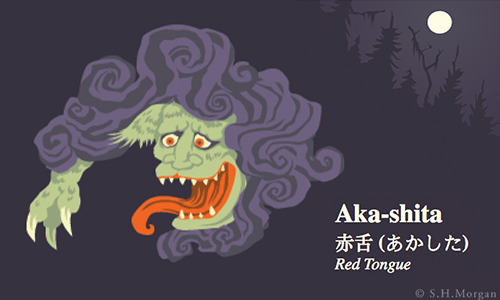
Aka-shita
赤舌 (あかした)
Red Tongue
From the now defunct website Obakemono Project:
This hairy beast, whose name means "red tongue", appears leering out of a black cloud over a floodgate in the third volume of Sekien Toriyama's Gazu Hyakki Yakō. It appears to have been based on the akakuchi.
(赤口, red mouth), a monster from a Kano school picture scroll.
This creature's name may have been taken from one of the six auspicious labels of the Japanese calendar, shakkō (also 赤口, red mouth), which indicates a day of terrible luck and atrocity. Sekien's creature, with its lolling tongue, may have itself been based on the Shakuzetsu-jin (赤舌神, red-tongue deity) of Onmyōdō, a name that indicates a god who guards the Western gate of Jupiter, or else one of the Indian Rakshasha.
Art by S.H.Morgan
Read more about the Aka Shita at Yokai.com and Yokai.wikia.com
Read a translation of Gazu Hyakki Yakō in Japandemonium by Matt Alt and Hiroko Yoda
#Aka-shita#akashita#obakemono project#yokai#youkai#japanese folklore#japanese monster#red tongue#S.H.Morgan
12 notes
·
View notes
Photo
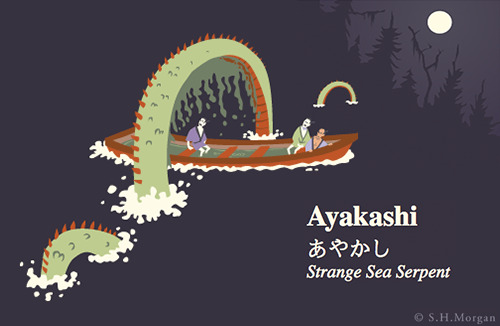
Ayakashi
あやかし
Strange Sea Serpent
other names: Ikuchi
From the now defunct website Obakemono Project:
Common in the Sea of Japan, the ayakashi is an enormous eel-like creature, not very big around but said to be several thousand meters in length. It sometimes will travel straight over a small boat in an arc, and it is so long that it takes two or three days to finish. In the meantime the men aboard the boat are thoroughly occupied, bailing out the abundant sheets of oil that spill from the ayakashi's body.
Art by S.H.Morgan
#ayakashi#obakemono project#sea monster#sea serpent#eel#japanese monster#japanese folklore#yokai#youkai
50 notes
·
View notes
Photo

Ama-no-jaku
天邪鬼 (あまのじゃく)
Wicked Demon of Heaven
From the now defunct website Obakemono Project:
A demon of ancient origin and numerous interpretations, the ama-no-jaku is the very spirit of contrariness and perversity. It is an invariably wicked being, usually depicted as a sort of small oni, which lives to torment and frustrate people. Sometimes it is said to be able to read human thought, and instigate human desire, all the better to make sure people get exactly the opposite of what they want.
It appears famously in a rather brutal version of the folktale Uriko-hime, in which it devours the beloved melon-princess on her wedding day, wears her flayed skin to impersonate her, and is then found out and beaten to death.
Art by S.H.Morgan
For more on Amanojaku;
onmarkproductions.com
Yokai.wiki.com
Yokai.com (Caution: the Yokai.com illustration is quite gory as it depicts Amanojaku after having skinned Uriko-hime. NSFW. Trigger warning for blood.)
#Amanojaku#ama-no-jaku#obakemono project#yokai#youkai#bakemono#oni#monster#japanese#folklore#demon#buddhism#yes this is were the Amanojaku from Ghost Stories came from
25 notes
·
View notes
Photo
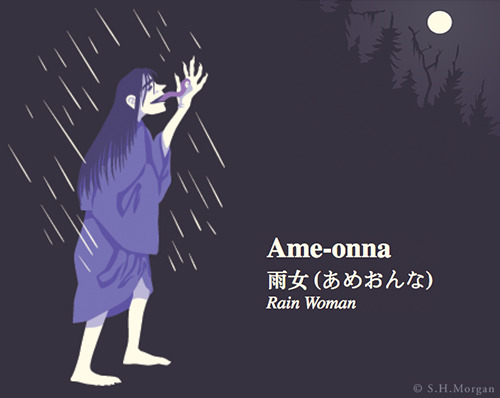
Ame-onna
雨女 (あめおんな)
Rain Woman
From the now defunct website Obakemono Project:
Said to be related to a Chinese mountain goddess who became a cloud in the morning and rain in the evening, this female spirit is herself less a monster and more a folk deity, who can be seen walking about in the human world on wet nights. Farmers, who depend so much on keeping their crops watered, still pray for the appearance of beings like the ame-onna, for wherever she travels, the rain falls.
Art by S.H.Morgan
Learn more about Ame-Onna
Yokai.com
Yokai Wikia
#ame-onna#ameonna#obakemono project#yokai#youkai#kami#rain woman#japanese folklore#japanese monster#obake#bakemono
33 notes
·
View notes
Photo
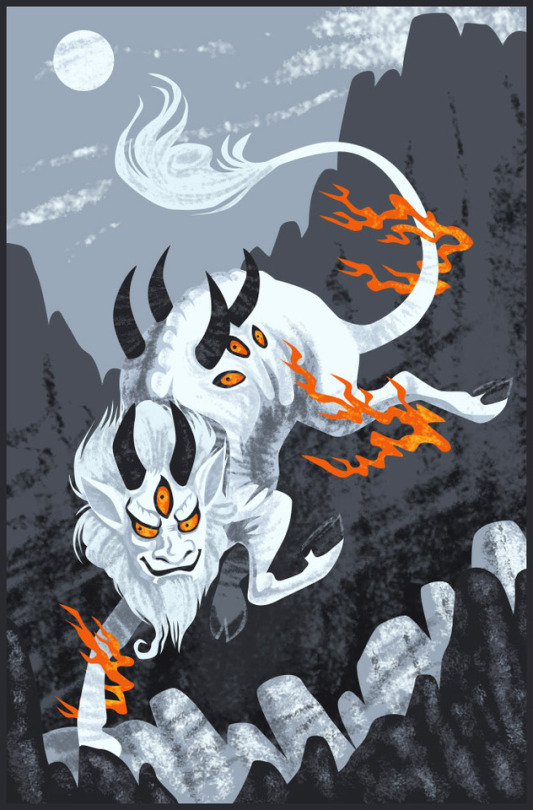
Hakutaku
白澤、白沢(はくたく)
White Marsh
Mandarin: Baí Zé
From the now defunct website Obakemono Project:
The New Book of Táng (新唐書) and the Book of Suí (隋書), the official histories of the Táng and Suí Dynasties of China, both record the existence of a now-vanished demonography of legendary origin.
Though the original text and illustrations have been lost, a few fragments of the Baí Zé Tú (白澤圖) survive, quoted in other texts. They all seem to be entries from a catalogue of demons, spooks and monsters, each one listing the type of spirit, its name, and the proper way to avoid being harmed by it or to exploit it for human gain.
One such entry goes:
The spirit of abandoned tomb mounds is named Wolf Demon (láng guǐ 狼鬼). It likes to engage people in combat and does not desist. Make a peach bow, jujube arrows, and attach kite feathers to them. Shoot it with them. If Wolf Demon becomes Whirling Wind (piāo fēng 飄風), remove a shoe, throw (the shoe) at it, and it cannot transform.
Another portion concerning the spirits of valuable minerals is quoted in the fifty-eighth volume of the Táng Dynasty manuscript Fǎ Yuàn Zhū Lín (法苑珠林):
The spirit of jade is called Daì Weǐ (岱委). It takes the form of a beautiful woman and wears blue clothes. When you come across it, if you stab it with a dagger made of peach wood and call out its name, it will become yours.
The spirit of gold is called Cāng Táng (see note). It has two heads on the body of a pig, and when you boil and eat it it has a flavor like dog's meat.
Just as interesting as the Baí Zé Tú's curious contents is the legend behind its authorship - it was apparently dictated by a monster itself. The story of how Huáng Dì (黄帝, the legendary Yellow Emperor) encountered the wise beast Baí Zé while he was touring in the East was recorded in several sources from the Sixth Century onward. One version of the Yellow Emperor's legend states:
Huáng Dì made an imperial visit to inspect the East, and when he went up a mountain here called Mount Huán (桓山), he met a god-beast called Baí Zé. This beast spoke human language well, and knew everything there was to know about every single thing in all of creation. Then the Baí Zé said that, of spirits which have hardened their vital essence and achieved physical form, and apparitions produced by the changing of playful spirits, there are approximately 11520 kinds. Here Huáng Dì commanded that drawings be made based on the things recited by the Baí Zé, and that they be shown to all under heaven, and it became the book called the Baí Zé Tú.
The Baí Zé is also mentioned in the Classic of the Mountains and Seas (山海経) as a creature living on Mount Dōng Wàng (東望山) in Jiāngnán. It is adept at speaking and appears when the king is virtuous.
In China the Baí Zé beast is usually portrayed with a lion-like shape, but when it was imported to Japan its image became slowly altered, first with horns and hooves and later with a bearded human face, an extra eye in the forehead and two horns and three eyes on each flank, leaving it with an auspicious nine eyes. This fortuitous image, representing a creature who removed the harm of evil spirits, became very popular as a good luck charm in the Edo Period. Today many representations the Hakutaku (the Baí Zé's Japanese name) remain, as protective amulets for travelers and against calamity and disease, as the guardian deities of medicinal shops, and as all manner of objects created in pursuit of a better fortune.
Art by S.H.Morgan
You can read more about Hakutaku at Yokai.com and Yokai.Wikia.Com
And check out more Obakemono Project posts in Jigoku Yeah’s Obakemono Project tag
#hakutaku#obakemono project#yokai#youkai#monster#japanese folklore#chinese folklore#bai ze#obake#bakemono
35 notes
·
View notes
Photo
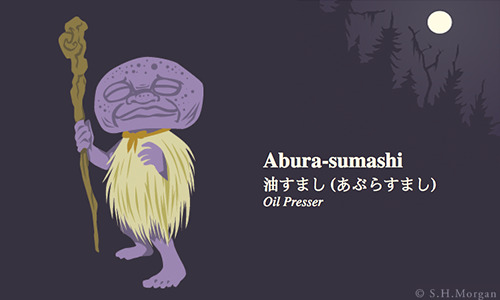
Abura-sumashi
油すまし (あぶらすまし)
Oil Presser
From the now defunct site Obakemono Project:
The abura-sumashi is a creature said to have appeared at one time on the island of Amakusa in Kumamoto Prefecture, on a mountain pass called Kusazumigoe (草隅越). According to the story usually told about this spirit, an old woman was once walking her grandchild along this pass, when she recited a story she'd heard, in which the abura-sumashi would appear in that place, dangling an oil bottle. At that moment the abura-sumashi showed up again, proclaiming that he still appeared.
This story was introduced to Japan by Yanagita Kunio, who in turn took it from the work of one Hamada Ryūichi, a folklorist who lived on Amakusa. This yōkai attained considerable popularity by appearing in the work of cartoonist Mizuki Shigeru, who drew it clad in a straw raincoat and sporting a stony, potato-shaped head.
The abura-sumashi's name can be translated as "oil wringer", from abura (oil) and sumasu, a word from Amakusa dialect which means to "press, wring, or squeeze". It seems to be related to the production of katashi-abura ("hardship oil", taken from the seeds of the Camellia sasanqua plant) which was once prosperous in the Kawachi district of the island.
Art by S.H.Morgan
Read more about Abura Sumashi at Yokai.com or Yokai.wikia.com
#abura sumashi#obakemono project#yokai#japanese folklore#japanese monster#monster#forest spirit#oil presser#youkai
61 notes
·
View notes
Photo

Hainu
羽犬 (はいぬ)
Winged Dog
From the now defunct website Obakemono Project:
This winged dog is a popular image in the city of Chikugo in Fukuoka Prefecture, and the dog itself is supposedly buried beneath a stone monument near the railroad station called Hainutsuka ("winged-dog mound"). Two conflicting stories are usually told about the winged dog's origins.
According to the first story, recorded in the Chikugo Kokorogashi in 1777, the winged dog was a ferocious creature which attacked humans and livestock. When Toyotomi Hideyoshi embarked on his Kyūshū Campaign of 1587, seeking to conquer the island, the dog stood in his way and had to be slain. Hideyoshi was so taken with the animal's pluck and courage, however, that he erected a memorial for it.
According to the second version, the dog was Hideyoshi's beloved pet, which died in the place where the mound now stands. There is some historical evidence for this latter version, and the imaginary winged dog of Chikugo's folklore may be based on a real dog of exceptional agility.
Art by S.H.Morgan.
95 notes
·
View notes
Photo
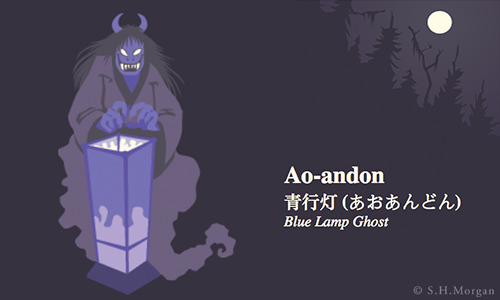
Ao-andon
青行灯 (あおあんどん)
Blue Lamp Ghost
other names: Ao-andō
From the now defunct website Obakemono Project:
In the Edo period, a popular pastime was hyaku monogatari, or "a hundred stories". A crowd of people would gather in a room where a hundred candles were burning inside andon lamps, which had been covered in blue paper to create an eerie atmosphere. Then a hundred frightening supernatural tales would be told, and after each one was finished, a candle would be put out. When the last story was told and the room went dark, the demon called ao-andon was said to appear.
Art by S.H.Morgan
Learn more about Ao-andon at
Hyakumonogatari.com
Yokai.com
Yokai Wiki
#ao andon#yokai#japanese folklore#ghost#monster#japanese monster#blue lamp ghost#lantern ghost#hyaku monogatari#obake#bakemono#youkai
15 notes
·
View notes
Photo
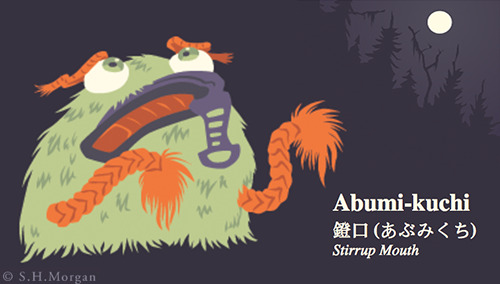
Abumi-kuchi
鐙口 (あぶみくち)
Stirrup Mouth
From the now defunct website Obakemono Project:
A strange furry creature formed from a stirrup, illustrated in the Gazu Hyakki Tsurezure Bukuro. The accompanying poem suggests that it once belonged to a man who has fallen in battle, and now shares in his misfortune:
膝の口をのぶかにいさせてあぶみを越して
おりたゝんとすれども、なんぎの手なればと、
おなじくうたふと、夢心におぼへぬ。
An arrow is shot deep into the knee, and he falls from his stirrups, and the hand of suffering is dealt, and such a song is sung, I saw it not in my dreaming mind.
Art by S.H.Morgan
You can read more about Abumi-kuchi on Yokai.com and a translation of Hyakki Tsurezure Bukuro in Japandemonium by Matt Alt and Hiroko Yoda.
And check out more Obakemono Project posts in Jigoku Yeah’s Obakemono Project tag
#Abumi-kuchi#abumiguchi#obakemono project#tsukumogami#yokai#youkai#japanese folklore#japanese monster#skyrim meme
10 notes
·
View notes
Photo

Rokuro-kubi
ろくろ首 (ろくろくび)
Pulley Neck
From the now defunct website Obakemono Project:
Rokuro-kubi are yōkai that used to be ordinary human beings, but somehow they have come to suffer from a ghostly affliction that allows their heads to float away from their bodies, their necks stretching in between like a fleshy garden hose, sometimes indefinitely. Usually they are women.
The rokuro-kubi's condition is sometimes brought about by a curse, and sometimes as a supernatural
manifestation of the person's desires. The neck-stretching almost always happens at night, often while the
rokuro-kubi sleeps, and the freed head may wander through the house perpetrating such obake-esque
mischief as sucking the life energy out of people and animals, and licking up the oil of andon lamps.
Some of them simply wind up using lintels high above doors and windows as their pillows, and scaring
the living daylights out of anyone who happens to peek in on them.
Rokuro-kubi women are often unlucky in love, frightening their new husbands away when the men discover
their wives’ unnerving nocturnal abilities.
Art by S.H.Morgan
#rokurokubi#yokai#Obakemono Project#S.H.Morgan#monster woman#monster girl#neck#obake#obakemono#youkai#japanese#kimono#japanese monster#japanese mythology#japanese folklore#body horror
26 notes
·
View notes